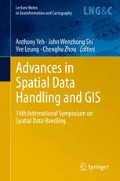Abstract
Automated evaluation of generalization output relies largely on well defined map specifications or cartographic constraints to formalize quality criteria or user requirements, and on enriched information to fully automate the process. Previous studies suggest that the formalization and evaluation of legibility constraints (i.e. those improving the readability of maps) are relatively easier than preservation constraints (i.e. those preserving important geographic characteristics and patterns). Patterns are important structures and should be taken into account by the evaluation process. This paper aims at a methodology in which the preservation of building patterns can be evaluated automatically. Three major difficulties in the process are identified and addressed: (1) pattern classification, characterization and detection, (2) pattern matching, and (3) constraint formalization. In addition, the knowledge of transition events describing allowed changes to building patterns at scale transitions is obtained via studying existing topographic maps (from 1:10 k to 1:100 k). Based on this knowledge, automated matching of corresponding building patterns is done much easier. Finally, the proposed methodology is implemented and validated by being applied to the evaluation of an interactively generalized dataset against its initial dataset. The results show the potential of the methodology and that the generalized patterns tend to remain the same or become more regular with respect to the initial ones. We also identify further improvement for practical use in an overall evaluation process to indicate acceptable generalization solutions.
Access this chapter
Tax calculation will be finalised at checkout
Purchases are for personal use only
References
Alt H, Godau M (1995) Computing the Fréchet distance between two polygonal curves. Int J Comput Geom Appl 5(1–2):75–91
Anders KH (2006) Grid typification. In: Riedl A, Kainz W, Elmes GA (eds) Progress in spatial data handling. Springer, Vienna, pp 633–642
Bard S, Ruas A (2004) Why and how evaluating generalised data? In: Developments in spatial data handling (SDH’04), Spring, Leicester, pp 327–342
Bobzien M, Burghardt D, Petzold I, Neun M, Weibel R (2008) Multi-representation databases with explicitly modeled horizontal, vertical, and update relations. Cartogr Geogr Inform Sci 35(1):3–16
Burghardt D, Schmidt S, Stoter J (2007) Investigations on cartographic constraint formalisation. In: 10th ICA workshop on generalisation and multiple representation, Moscow. Available at http://aci.ign.fr/BDpubli/moscow2007/Burghardt-ICAWorkshop.pdf
Devogele T, Trevisan J, Raynal L (1996) Building a multi-scale database with scale-transaction relationships. In: Kraak MJ, Molenaar M (eds) Proceedings of the 7th international symposium on spatial data handling (SDH’96), Taylor & Francis, Delft, pp 337–351
Hampe M, Anders K, Sester M (2003) MRDB applications for data revision and real-time generalization. In: Proceedings of the 21st international cartographic conference, Durban, pp 192–202
Lüscher P, Weibel R, Burghardt D (2009) Integrating ontological modelling and Bayesian inference for pattern classification in topographic vector data. Comput Environ Urban 33:363–374
Mackaness WA, Ruas A (2007) Evaluation in the map generalisation process. In: Mackaness WA, Ruas A, Sarjakoski LT (eds) Generalisation of geographic information: cartographic modelling and applications. Elsevier, Amsterdam, pp 89–111
Mascret A, Devogele T, Berre IL, Hénaff A (2006) Coastline matching process based on the discrete Fréchet distance. In: Riedl A, Kainz W, Elmes GA (eds) Proceedings of the 12th international symposium on spatial data handling, Vienna, pp 383–400
Mustière S, Devogele T (2007) Matching networks with different levels of detail. Geoinformatica 12(4):435–453
Mustière S, Sester M, van Harmelen F, van Oosterom P (2009) 09161 Abstracts collection – generalization of spatial information. In: Mustière S, Sester M, van Harmelen F, van Oosterom P (eds) Generalization of spatial information. Schloss Dagstuhl – Leibniz-Zentrum fuer Informatik, Germany
Regnauld N (1996) Recognition of building clusters for generalization. In: Kraak MJ, Molenaar M (eds) Advances in GIS research II (Proceedings of 6th SDH’96, Delft), Taylor & Francis, London, pp 4B.1–4B.14
Ruas A, Holzapfel F (2003) Automatic characterisation of building alignments by means of expert knowledge. In: Proceedings of the 21st international cartographic conference (ICC), Durban, South Africa, 10–16 Aug 2003, pp 1604–1615
Schmid S (2008) Automated constraint-based evaluation of cartographic generalization solutions. Unpublished MSc thesis, Department of Geography, University of Zurich
Stoter J et al (2009a) Methodology for evaluating automated map generalization in commercial software. Comput Environ Urban 33:311–324
Stoter J, van Smaalen J, Bakker N, Hardy P (2009b) Specifying map requirements for automated generalization of topographic data. Cartogr J 46(3):214–227
Tversky A (1977) Features of similarity. Psychol Rev 84:327–352
Weibel R, Dutton GH (1998) Constraint-based automated map generalization. In: Poiker, TK, Chrisman N (eds) Proceedings of the 8th international symposium on spatial data handling, Vancouver, pp 214–224
Zhang M, Meng L (2007) An iterative road-matching approach for the integration of postal data. Comput Environ Urban 31(5):597–615
Zhang X, Ai T, Stoter J (2010) Characterization and detection of building patterns in cartographic data. In: Joint international conference on theory, data handling and modelling in GeoSpatial information science, Hong Kong, vol XXXVIII, Part 2, pp 261–266
Acknowledgments
This work was partly supported by the 863 Program (Grant No. 2009AA121404). Faculty of Geo-Information Science and Earth Observation (ITC) of the University of Twente, which funds the first author as a PhD student, is gratefully acknowledged.
Author information
Authors and Affiliations
Corresponding author
Editor information
Editors and Affiliations
Rights and permissions
Copyright information
© 2012 Springer-Verlag GmbH Berlin Heidelberg
About this paper
Cite this paper
Zhang, X., Stoter, J., Ai, T., Kraak, MJ. (2012). Formalization and Data Enrichment for Automated Evaluation of Building Pattern Preservation. In: Yeh, A., Shi, W., Leung, Y., Zhou, C. (eds) Advances in Spatial Data Handling and GIS. Lecture Notes in Geoinformation and Cartography. Springer, Berlin, Heidelberg. https://doi.org/10.1007/978-3-642-25926-5_9
Download citation
DOI: https://doi.org/10.1007/978-3-642-25926-5_9
Published:
Publisher Name: Springer, Berlin, Heidelberg
Print ISBN: 978-3-642-25925-8
Online ISBN: 978-3-642-25926-5
eBook Packages: Earth and Environmental ScienceEarth and Environmental Science (R0)

